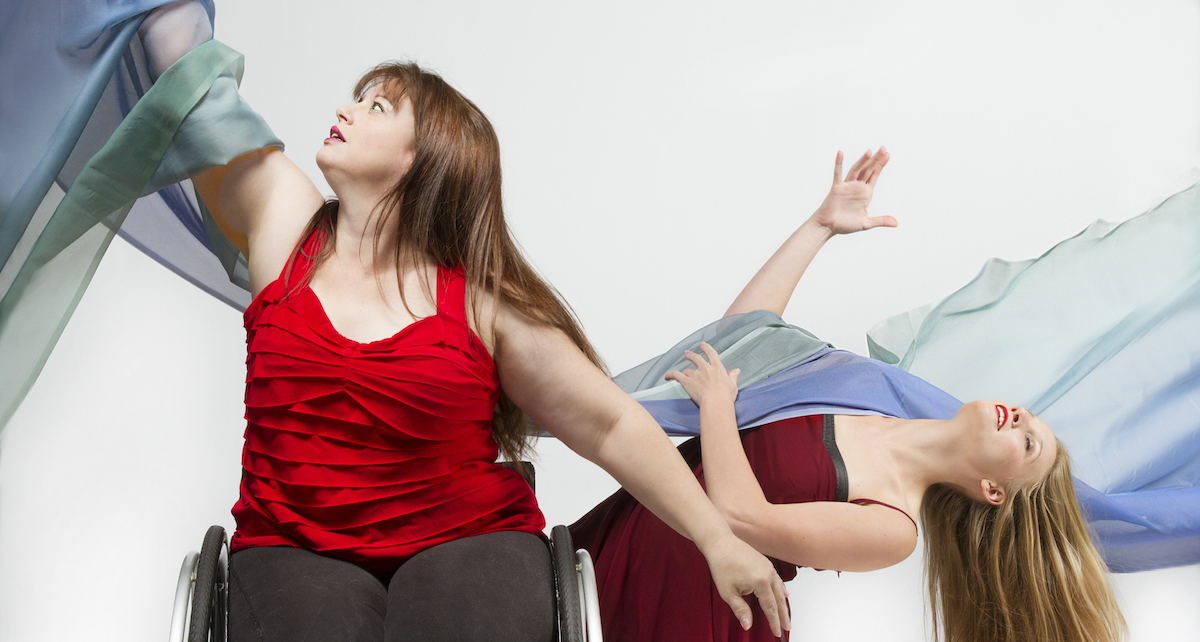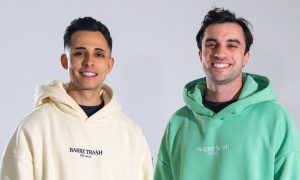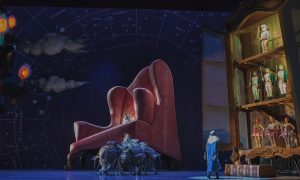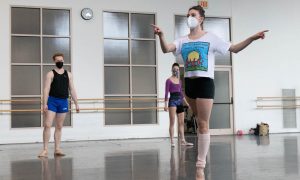Based in Atlanta, Georgia, Full Radius Dance is a widely renowned physically integrated company. The 2017 season marks the company’s 25th anniversary of creating artistic modern dance work that pushes physical and technical boundaries. The company’s anniversary performance, Silver, takes place on March 10 and 11, at Atlanta’s 7 Stages Theatre MainStage. Here, Dance Informa speaks with Artistic Director Douglas Scott, a 2014 recipient of the Governor’s Award for the Arts and Humanities, to learn more about the company and how it is celebrating this monumental anniversary.
What motivated you to establish Full Radius Dance?
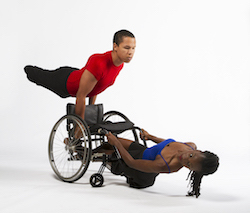
Full Radius Dance. Photo by Bubba Carr.
“I founded a dance company, known as Dance Force, in 1991. The company began as a traditional dance company – all members were professional dancers without disabilities. In 1993, through a partnership with VSA arts of Georgia, Shepherd Center and Special Audiences, I began teaching classes for persons with physical disabilities. In 1995, I was asked to create dances for the Arts Festival of Atlanta-commissioned production of Visage En Face with rock band Van Gogh. Ardath Prendergast (a dancer/choreographer and arts administrator with VSA arts of GA) and I enlisted several members of the dance class, and on a foggy evening at Atlanta’s Piedmont Park, launched the first performance of the dance company E=Motion. Although included under the Dance Force Board of Directors and fiscal sponsorship, E=Motion operated separately from the Dance Force company until the feasibility of this bold venture was determined. The company soon thrived. In 1998, E=Motion merged with Dance Force to create Full Radius Dance with me serving as Artistic/Executive Director and Ardath as Artistic Associate, a position she held until her relocation in 2003.
At the time I founded Dance Force, I was active in aerial work (trapeze and Spanish Web). I had a deep interest in how far I could push my body physically. When I started working with dancers with disabilities, I was intrigued by their physicality. They differed from my own. I soon found that these were the bodies with which I wanted to tell my stories. As a sculptor may use stone or a painter, oils, I prefer physically integrated dance as my medium.”
How has your work evolved over the years? What has changed, and what has stayed the same?
“My evolution as an artist has changed the work I produce. As I found and grew more confident in my voice, my work has grown in complexity, going deeper in intent and subject.
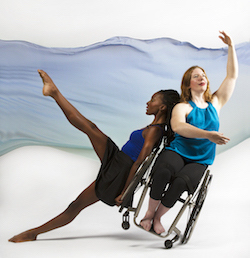
Full Radius Dance. Photo by Bubba Carr.
What has stayed the same is my commitment to dramatic structure. Aristotle put forth that a whole is what has a beginning and middle and end. I’d reframe that to the whole has a starting point, an exploration and a resolution. Each of my dances has a beginning, a starting point. That’s the moment the lights come up, when I’ve shared with my audience the first visual image. In the first few seconds, I’ve made a commitment that this snapshot will make complete emotional sense at the end of our journey together. The next parts of my dances are explorations – examining, probing and discovering the implications of my starting image. I often use time as a fluid concept in my choreography. Events may occur in a non-sequential order. After all, in our mind, don’t we often leap between past, present and anticipated occurrences? I like the term ‘resolution’ over the term ‘ending’. Ending implies that you’ve finished the journey. Resolution says that you’ve come to an understanding but are open to further discovery.”
Works performed by Full Radius Dance highlight unexpected possibilities for movement, rather than conjuring any ideas of limitation. Please share a glimpse of the company’s creative process.
“In Full Radius Dance, we believe that physically integrated dance is not just about the disabled body but about the bodies of all the dancers, nondisabled and disabled. This genre communicates an awareness and acceptance of the body and a deep sense of recognition about the power and potential of the body. Our interest is in complementing each dancer’s strengths and abilities, not in creating a framework in which the dancers with disabilities are showcased or emphasized simply due to disability. This belief frames our creative process.
The choreographic process is collaborative. I’ll bring in movement for the dancers who use wheelchairs and ask the dancers without disabilities to transpose the movement to their body, or vice versa. Other times, I’ll have the beginning of a duet phrase, set it on the dancers, and observe the movement on the bodies. That gives me clues to what direction the dance will go. Or a lift doesn’t go quite like I envisioned but what the dancers give me is better.
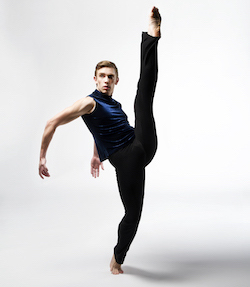
Full Radius Dance. Photo by Bubba Carr.
Some movement is generated in the studio, through improvisation; other movement is created by the dancers on their own body or in tandem with another dancer or two. I then watch, provide feedback, help refine, et cetera.
Sometimes it involves looking at the dance in a new way. For instance, one of the works we are reviving, Passioné (2006), has a section that doesn’t match my current artistic sensibilities. So, in today’s rehearsal, I asked the dancers to show me what it would look like performed as a duet instead of two solos. Yes. Much better!”
How did you select the retrospective pieces for the Silver Anniversary Program?
“Full Radius Dance is noted for the depth and expertise of our partnering work, so I cast my eye back through the seasons to revive works that display this. It was a little overwhelming when confronted with the vast body of work of 25 years. I chose work that would fit the current dancers and would hold the interest of our current audiences. Some of the work was created for the specific bodies of the performers. These works could have been revived but would call for substantial revisions. I wanted to remain as true to the original choreography as possible, with a few exceptions.”
How is the premiere of your work Do You Know What You Are Doing Now important within the context of the company’s Silver Anniversary season?
“It’s me, taking a step back over 25 years and looking toward the future. When I was 18, I thought I’d have it all figured out by 25. Then I got to age 25, hadn’t figured anything out, so 30 must be the magic age. Nope. Maybe 40? And now, I’m 55 and still wondering when!
Do You Know… speaks to how insecurity causes uncertainty and anxiety about oneself, others, the situation, and the process of creation. As noted American actress Meryl Streep said, ‘I have various degrees of confidence and self-loathing…You can have a perfectly horrible day where you doubt your talent….Or that you’re boring and they’re going to find out that you don’t know what you’re doing.'”
Full Radius Dance is committed to community outreach. Please share information about your current offerings and how they fit into the company’s mission.
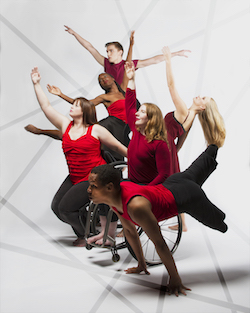
Full Radius Dance. Photo by Bubba Carr.
“For Silver, our major community outreach is a free-of-charge show specifically for youth and adults with disabilities. We’ll be performing Dance Me a Story: Three Moving Tales. The tales are The Ugly Duckling, Dr. Seuss’ The Sneetches and an original story created on the spot. Traditionally, audiences fill the theatre to capacity.
This performance squares nicely with our values statement and illustrates it beautifully. Full Radius Dance believes: Your body is perfect. Your body has undiscovered movement. Your body should experience dance.”
Full Radius Dance sponsors the Modern Atlanta Dance (MAD) Festival. What is planned for this year’s festival?
“The 23rd annual MAD Festival takes place on May 12 and 13, at the Balzer Theater at Herren’s. This year’s lineup is Gregory Catellier and Kristen O’Neal, Alice Halter, Kamali Hill, Sarah Wildes Arnett, Corian Ellisor, Melissa Pihos and Full Radius Dance. The MAD Festival will also honor former Atlanta Ballet Artistic Director Robert ‘Bobby’ Barnett and, posthumously, his wife Virginia ‘Ginger’ Barnett with the Pioneer of Atlanta Dance Award.”
From where do you secure funding for rehearsal, production and talent costs?
“Almost an equal split between grants (City of Atlanta, Fulton County, et cetera), earned income (ticket revenue, contracted performance fees) and individual donors. We love our individual donors!”
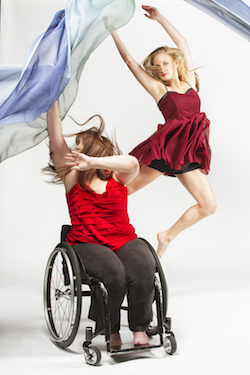
Full Radius Dance. Photo by Bubba Carr.
What’s next on the ‘to-do list’ for Full Radius Dance?
“Expanding our national and international presence. We’ll be making our NYC debut in fall of 2017 underwritten by the Dance. Disability. Artistry. Fund of Dance/NYC. We’ve been invited to perform at the Una Mirada Diferente Festival in Madrid, Spain, this spring and are working on making that a reality. I’ll be leading a workshop on Technique for Diverse Bodies at the MeetShareDance Festival in Berlin, Germany, in August 2017.”
Tickets to Silver, to be presented March 10-11, at Atlanta’s 7 Stages Theatre, may be purchased by clicking here. Connect with and learn more about Full Radius Dance at fullradiusdance.org.
By Emily Yewell Volin of Dance Informa.


